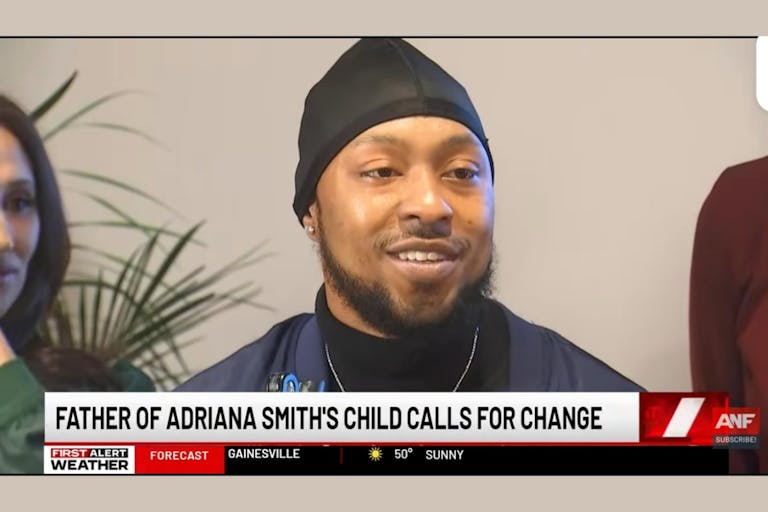
Court grants baby Chance's father sole custody
Nancy Flanders
·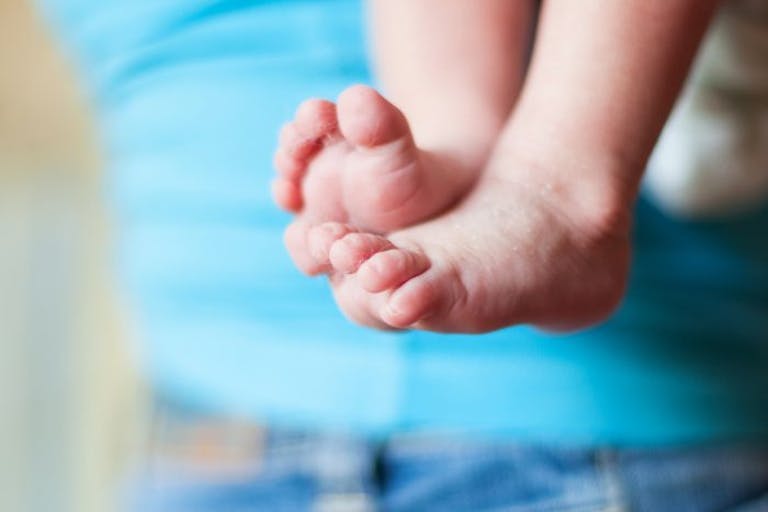
Investigative·By Carole Novielli
As adoptions decline overall, special needs adoptions are rising
A report on adoption numbers published earlier this year shows that over the past several years, the number of special needs adoptions has nearly doubled, despite declining adoption numbers overall.
According to data collected by the National Council for Adoption (NCFA), in 2014, children with special needs comprised almost nine-tenths (61,341 or 88.5 percent) of unrelated domestic adoptions. The Council, which began publishing data on adoption in 1985, found that between 2007 and 2014 the number of special needs adoptions nearly doubled—increasing from 32,402 in 2007 to 61,341 in 2014.
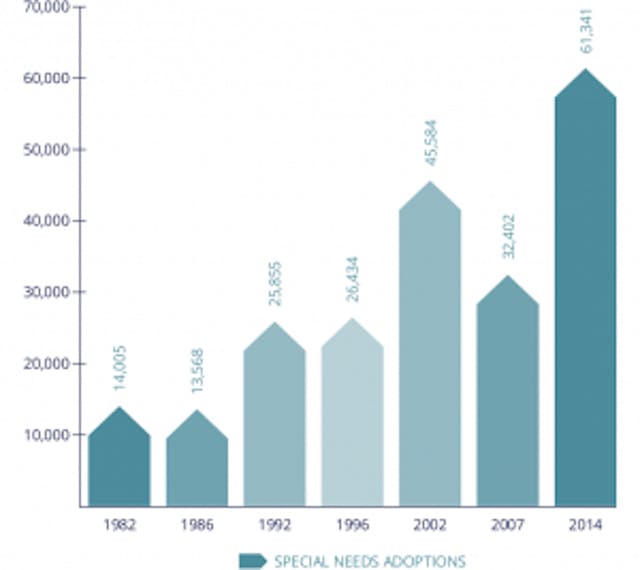
According to the report, entitled, “National Adoption Data Assembled by National Council For Adoption,” by Jo Jones, Ph.D. and Paul J. Placek, Ph.D:
…the high number of “special needs” adoptions can be attributed to the fact that the definition is not necessarily the customary societal understanding of special needs.
In foster care, “special needs” may refer to any child who qualifies for adoption assistance due to special factors such as being an older child, having a particular racial or ethnic background, being part of a sibling group who need to be placed together, or having physical, mental, or emotional disabilities or medical condition.
The February 2017 report shows that overall, adoption numbers have fallen over the past years from a count of 133,737 adoptions in 2007 to 110,373 (41,023 related adoptions and 69,350 unrelated adoptions) in 2014. More than half of this decline can be attributed to the significant drop in the number of intercountry adoptions by Americans as well as a decline in the number of kinship or related adoptions, the report states.
The report also found:
In 2014, the largest number of unrelated domestic adoptions was handled by public agencies (47,094), and the rest were handled by private agencies (16,312) or were independent adoptions handled by private individuals, usually attorneys (5,944).
INFANT ADOPTIONS:
In 2014, there were 4.6 domestic infant adoptions per 1,000 live births in the United States indicating that less than one-half of one percent of infants were placed for adoption, NCFA reported.
In addition, only about one percent of unmarried mothers chose adoption for their infants.
But the report also found that infant adoptions have remained steady, despite the fact that the number of births to single parents has decreased significantly since 2007.
FOSTER CARE ADOPTIONS:
NCFA found that while the number of children being adopted from foster care increased in 2014, the number of children waiting to be adopted from foster care has also increased.
Preliminary estimates of Adoption Statistics for fiscal year 2015, published by the U.S. Department of Health and Human Services Administration for Children and Families, Administration on Children, Youth and Families, Children’s Bureau, show that nationally, 53,549 were adopted out of the foster care system in 2015 while 111,820 were waiting to be adopted.
A report on adoptions, published in April 2017 by Fox News, stated that the majority of children adopted out of foster care were five or younger, while those still waiting to be adopted were seven or older.
Tragically, more than 20,000 foster youth “age out” of the system each year without having found an adoptive home, Fox News wrote.
ABORTIONS and ADOPTIONS:
According to the NCFA, in 2014, there were 265.4 abortions for every 1,000 live births, or about 27 abortions per 100 live births in the United States.
There were 17.3 infant adoptions per 1,000 abortions in 2014.
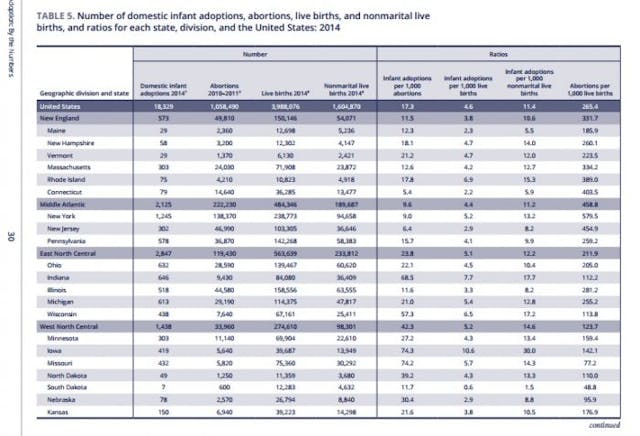
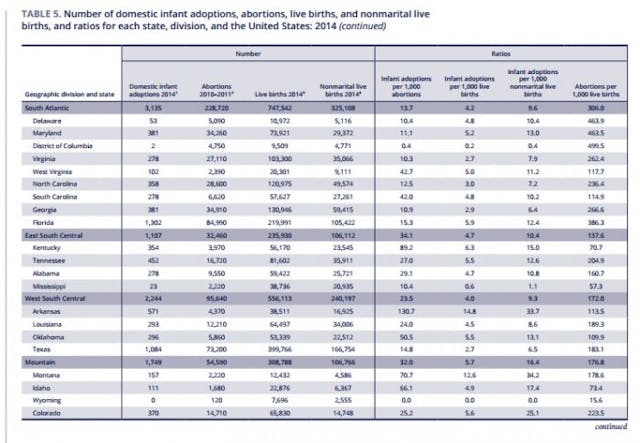
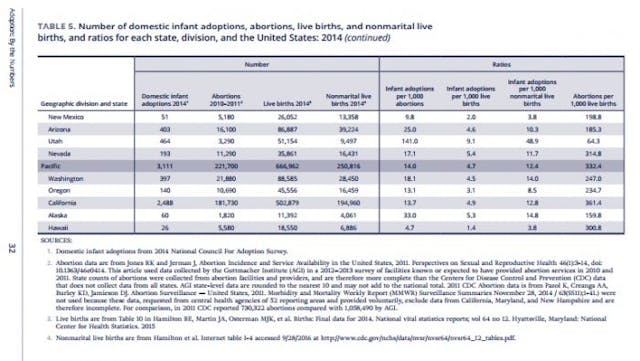
NCFA also discovered several interesting facts that may indicate which states are having more success in offering the adoption option to women who may seek an abortion:
There are five states which have infant adoptions per 1,000 nonmarital live births ratios twice as large as the national average of 11.4 in 2014—Utah (48.9), Montana (34.2), Arkansas (33.7), Iowa (30.0), and Colorado (25.1)—indicating higher relative success than the national average in providing adoption assistance to unmarried women who would otherwise parent the baby.
Arkansas and Utah also have much higher ratios of adoptions per 1,000 abortions—130.7 and 141.0, respectively—compared with the national average (17.3 adoptions per 1,000 abortions) and other states. Again, these ratios indicate that these states may have more relative success in offering the adoption option to women who would otherwise choose abortion.
Other states with higher adoption-to-abortion ratios include: Kentucky (89.2), Iowa (74.3), Missouri (74.2), Montana (70.7), Indiana (68.5), and Idaho (66.1).
According to the NCFA, unmarried females who became pregnant were more likely to place their children with adoptive families. In order to determine the average number of potentially adoptable infants, NCFA developed what they referred to as the “Adoption Option Index,” to help, “gauge the level of services and to obtain more resources to make the adoption option a choice selected more often.”
“This is the first index ever constructed to indicate the relative frequency of infant adoptions to that group of pregnancy outcomes that could potentially yield adoptions,” the authors wrote.
Using the formula below, NCFA determined the average Adoption Option Index in the US for 2014 was 6.9.
Article continues below
Dear Reader,
In 2026, Live Action is heading straight where the battle is fiercest: college campuses.
We have a bold initiative to establish 100 Live Action campus chapters within the next year, and your partnership will make it a success!
Your support today will help train and equip young leaders, bring Live Action’s educational content into academic environments, host on-campus events and debates, and empower students to challenge the pro-abortion status quo with truth and compassion.
Invest in pro-life grassroots outreach and cultural formation with your DOUBLED year-end gift!

After crunching the numbers with this formula, NCFA found that four states (Utah, Arkansas, Montana, and Iowa) had adoption option indexes three or more times higher than the national average. There were two to four adoptions for every 100 abortions plus births to unmarried women in these states.
“This suggests that in these states women may have more extensive counseling, services, and facilities to orient pregnant women towards adoption—among other factors,” the authors wrote.
Tragically, seven states had indexes which were one-half the national average, indicating a much lower level of adoption activity than the national average, the report states.
NCFA concluded in their analysis of the data that “adoption choices may depend on support services.”
INTERNATIONAL ADOPTIONS:
Children were adopted into families in the United States from several countries in FY 2016, including Canada, Ireland, Mexico, Austria, Great Britain, the Netherlands, Austria, and Switzerland, according to a recent State Department report.
In total there were 5,372 international adoptions. Texas showed the largest number of finalized international adoptions (337) with Illinois the next highest (244), then Ohio (184) and Florida (182) coming in third and fourth. Adoption service providers (ASPs) reported charging between $0 and $64,357 for all adoption services, with half charging less than $30,072 and half charging more, the report claimed.
But the report also found that the numbers of international adoptions have been in decline.
In 2015, there were 5,648 adoptions — more than 76 percent below the high of 22,884 in 2004.
The Department identified three major issues impacting the viability of intercountry adoption:
Delays in completing post-adoption reports for children already adopted.
Countries’ concerns about illegal or unethical practices by adoption service providers (ASPs) and the ability to appropriately monitor ASP activities.
Concerns about the unregulated custody transfer (sometimes referred to as “rehoming”) of adopted children.
Chuck Johnson, CEO of the NCFA, told Fox News that he estimates approximately 1 million families are trying to adopt at any given time. “No matter where they go, unless they’re super lucky, they’re going to be in for a long wait,” Johnson said. “They’re going to be in a slow, painful process for foster care or in this massive competition for the limited number of healthy infants — and that’s where the situation is ripe for fraud. There are so many families who want to adopt, and so few options for them.”
To date, 100 million Americans have either been personally touched by adoption within their families or know someone who has adopted or has been adopted, according to NCFA.
Despite the dropping numbers, it is plausible that the support provided by pro-life pregnancy centers to women experiencing unplanned pregnancies could be having an impact, enabling more women to keep their babies.
But sadly, not enough are being reached.
According to the latest abortion statistics, there were at least 926,200 abortions in 2014, with Planned Parenthood performing that largest share of those procedures (about 35 percent).
Live Action News has documented that Planned Parenthood offers few services to pregnant women other than abortion. This includes a stunning lack of prenatal care, which the organization’s own reports show has decreased nearly 70 percent since 2010.
Planned Parenthood’s newly released 2015-2016 annual report revealed that prenatal care services were nearly cut in half from 2014, dropping to 9,419 from 17,419. In other words, Planned Parenthood performed 35 abortions for every prenatal care service it provided.
Adoption referrals were not much better. The report showed that while Planned Parenthood performed a staggering 328,348 abortions, they referred just 2,889 women to outside agencies for adoption. (Naturally, Planned Parenthood counts these outside referrals as “services” it provided.)
And, despite a slight increase in adoption referrals from the previous year, between 2007 and 2015, adoption referrals to other agencies declined by 41 percent at Planned Parenthood.
In addition, Planned Parenthood’s 2015 numbers reveal that the taxpayer-funded corporation performed nearly 114 abortions for every one adoption it referred out.
In 2014, Planned Parenthood referred slightly fewer women for adoptions than they reported in the 2015 report (2,024 to 2,889). Those 2014 numbers accounted for less than 2 percent (1.83%) of all adoptions performed nationally (110,373) and 9 percent of adoptions performed by just private agencies and attorneys (22,256) in 2014.
Live Action News is pro-life news and commentary from a pro-life perspective.
Contact editor@liveaction.org for questions, corrections, or if you are seeking permission to reprint any Live Action News content.
Guest Articles: To submit a guest article to Live Action News, email editor@liveaction.org with an attached Word document of 800-1000 words. Please also attach any photos relevant to your submission if applicable. If your submission is accepted for publication, you will be notified within three weeks. Guest articles are not compensated (see our Open License Agreement). Thank you for your interest in Live Action News!

Nancy Flanders
·
Abortion Pill
Carole Novielli
·
Investigative
Carole Novielli
·
Investigative
Carole Novielli
·
Investigative
Nancy Flanders
·
Investigative
Nancy Flanders
·
Abortion Pill
Carole Novielli
·
Abortion Pill
Carole Novielli
·
Investigative
Carole Novielli
·
Abortion Pill
Carole Novielli
·
Investigative
Carole Novielli
·